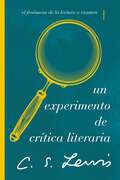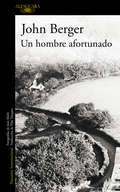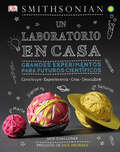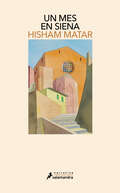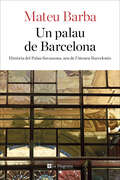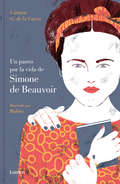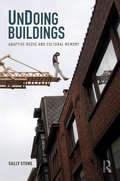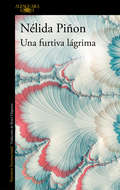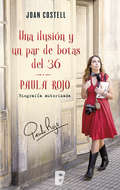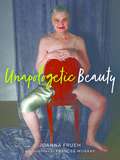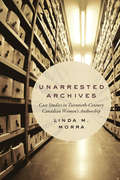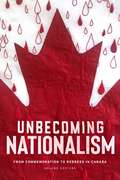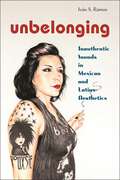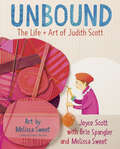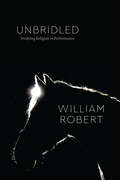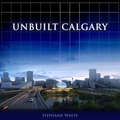- Table View
- List View
Un experimento de crítica literaria: El fenómeno de la lectura a examen
by C. S. LewisUn clásico de C. S. Lewis que nace de la convicción de que la literatura existe para el deleite del lector y que los libros deben ser juzgados por el tipo de lectura que invitan.Clive Lewis sostiene que la "buena lectura", al igual que la acción moral o la experiencia religiosa, implica la entrega a la obra en cuestión y un proceso de entrar de lleno en las opiniones de los demás: "al leer la gran literatura me convierto en mil hombres y sigo siendo yo mismo". Para su idea de juzgar la literatura es fundamental el compromiso de dejar de lado las expectativas y los valores ajenos a la obra, para acercarse a ella con una mente abierta.En medio de la compleja maraña de teorías críticas actuales, la sabiduría de C. S. Lewis es valiosamente realista, refrescante y estimulante en las cuestiones que plantea sobre la experiencia de la lectura en este clásico, Un experimento de crítica literaria.An Experiment in CriticismA C. S. Lewis's classic that springs from the conviction that literature exists for the joy of the reader and that book should be judged by the kind of reading they invite.Clive Lewis argues that "good reading," like moral action or religious experience, involves surrender to the work in hand and a process of entering fully into the opinions of others: "in reading great literature I become a thousand men and yet remain myself." Crucial to his notion of judging literature is a commitment to laying aside expectations and values extraneous to the work, to approach it with an open mind.Amid the complex welter of current critical theories, C. S. Lewis's wisdom is valuably down-to-earth, refreshing and stimulating in the questions it raises about the experience of reading.
Un hombre afortunado
by John BergerUna lúcida meditación sobre el valor que le asignamos a una vida humana y sobre cuál es el verdadero rostro de la medicina. En 1967 John Berger y el fotógrafo Jean Mohr acompañaron a John Sassall, un médico inglés que ejercía su profesión en una comunidad rural. La obra narra varias historias del trabajo de Sassall con sus pacientes, a la vez que revela pensamientos sobre su profesión y su vida para acercarnos gradualmente al hombre. Las fotografías de Jean Mohr marcan rasgos indispensables de la historia y dialogan con un texto lleno de reflexiones del propio Berger y otras procedentes del mundo literario y filosófico: de Conrad a Gramsci, de Piaget a Sartre. Con una prosa hipnótica, a mitad de camino entre la narración y el estudio antropológico, Un hombre afortunado, publicado por primera vez hace más de cuatro décadas, es un libro de absoluta vigencia, una lúcida meditación sobre el valor que le asignamos a una vida humana y sobre cuál es el verdadero rostro de la medicina. Reseñas:«Desde D. H. Lawrence no ha existido un escritor capaz de ofrecer al mundo tal atención sobre los problemas humanos más disímiles, con una sensualidad que no renuncia a los imperativos de conciencia y responsabilidad.»Susan Sontag «Un libro hermoso, maravillosamente escrito e ilustrado con llamativas y emotivas fotografías.»The Nation «Sus contemporáneos más cercanos en términos de audacia estética podrían ser Umberto Eco o el tardío W. G. Sebald, pero resulta difícil compararlo a cualquier autor inglés del último medio siglo. Berger, simplemente, rompió todos los moldes.»Sean O'Hagan «Un hombre afortunado merece leerse y considerarse con la calma de una obra maestra. Y esto no sólo por lo que denuncia, sino también por el esfuerzo de Berger puesto en la innovación literaria, de la que este libro es un ejemplo notable. Berger es un revolucionario de las formas.»Geoff Dyer «Fue la voz de los frágiles, residuos del mundo moderno a los que su obra otorgó dignidad de reyes... Poeta, novelista, ensayista y crítico de arte, toda su obra literaria es el testimonio de alguien que contempla un universo que se desvanece ante sus ojos.»Javier Rodríguez Marcos, El País «Un autor esencial... La mirada de Berger era tan profunda como diversa# Una mirada humanista, rebelde y serena al mismo tiempo, la de un renacentista# En pocos autores se ha producido la fusión que él logró entre imagen y escritura.»Pedro Antonio Curto, El Comercio «Fue el Leonard Cohen de otra clase de rotunda melancolía: la de la tristeza (social, íntima) que provoca el auténtico saber en mitad de la sociedad capitalista de fauces abiertas y hambre incansable... Era un activista, su literatura viene de ahí, del compromiso a la manera de Albert Camus, de la protesta, de la obsesión con el poder y sus lepras.»DiegoMedrano, El Comercio «Uno de los autores más irreverentes del siglo XX.»Elena Hevia, El Periódico de Aragón
Un laboratorio en casa: Grandes experimentos para futuros científicos (DK Activity Lab)
by Jack ChallonerGrandes experimentos para futuros científicosEste libro de experimentos científicos para niños contiene 28 proyectos brillantes, con explicaciones claras paso a paso, que requieren ingredientes cotidianos que pueden encontrarse en casa y fotografías que guiarán al joven científico desde principio a fin.Textos informativos explican el por qué y cómo de cada experimento, utilizando ejemplos de la vida real para que los niños entiendan la aplicación de los principios científicos.Construye un modelo de Sistema Solar con gomas elásticas, consigue que un barco navegue propulsado por jabón, fabrica tu propio slime o inventa la réplica de un volcán en erupción con Un laboratorio en casa, un libro lleno de grandes experimentos de ciencia para futuros científicos.Crea tu pequeño laboratorio en casa y diviértete experimentandoEste libro de experimentos para niños explora distintas formas de crear y experimentar para que los niños se diviertan aprendiendo tanto en casa como en espacios exteriores. Todos los experimentos recogidos en este libro para niños están diseñados de forma que los puedan realizar con objetos caseros.Este libro de ciencia para niños y futuros científicos ofrece 28 ideas brillantes, para que puedan experimentar tanto en casa como al aire libre con material casero. Además, cada experimento está anotado con su nivel de dificultad y el tiempo de duración medio.... ¡entretenimiento en casa asegurado! Este libro es perfecto para que niños de 8 a 12 años se inspiren para proyectos escolares y aprendan divirtiéndose en su tiempo libre.Un laboratorio en casa, pertenece a la sección infantil de la editorial DK, una sección donde podrás encontrar libros para niños de todas las edades. Los libros de esta sección cuentan con información clara, sencilla y están acompañados de ilustraciones que facilitan la compresión de cada texto. Además, favorecen el aprendizaje y desarrollo de los lectores más jóvenes.
Un libro lleno de maravillosas y emocionantes sorpresas
by Bernard Levine Nathaly López CerdaVas a amar leer sobre Cómo cubrir 30 números en la mesa de la ruleta usando sólo 5 fichas. Cómo tocar cualquier canción en guitarra o piano con sólo 3 acordes. El truco de cartas para leer la mente más grande del mundo. Cómo vender tus partituras por cientos de dólares. Juguetes de niños con los que amábamos jugar y lo que valen hoy en día. ¿Cuántos de los muchos modelos de automóviles clásicos y vintage del pasado recuerdas? ¿Cuál es el valor de tu colección de Cómics? Compañías que te pagarán por usar tus fotos en sus productos. Enseña Inglés u otras clases en línea y obtén un segundo ingreso. ¿Cuáles son los números secretos de la creación? ¿Te gustaría conseguir guiones gratis de shows de radio, TV, películas y obras que te encantan? ¿Conoces los Secretos del Amor? Descubre qué letra del alfabeto se imprime al revés en la Biblia. ¡Y mucho más! ¡Únete a la diversión!
Un libro pieno di entusiasmanti sorprese
by Simona Trapani Bernard LevineSarà interessante informarvi su: Come coprire 30 numeri sul tavolo da roulette usando solo 5 fiches. Come suonare qualunque canzone alla chitarra o al piano con soli 3 accordi. Il trucco con le carte migliore del mondo per leggere la mente. Come vendere i vostri spartiti per centinaia di dollari. I giocattoli che vi piacevano da bambini e il loro valore attuale. Quanti modelli di auto classici e vintage del passato vi ricordate? Quanto vale la vostra collezione di fumetti? Aziende che vi pagano per fotografare i loro prodotti. Fare lezioni d’inglese o di altre materie per avere un secondo reddito. Quali sono i numeri segreti della creazione? Come trovare i copioni gratuiti di programmi radiofonici e televisivi, film e spettacoli che vi piacciono? Conoscete i segreti dell’amore? Scoprire quale lettera dell’alfabeto è stampata capovolta nella Bibbia. E molto altro ancora! Buon divertimento!
Un livre de coloriage pour adultes, pour s'amuser et se relaxer, Volume 1
by Amber Richards Gaëlle GuilleaumeVous adoriez colorier quand vous étiez enfant ? Alors, redécouvrez les joies du coloriage en tant qu'adulte. Non seulement c'est amusant, mais en plus c'est relaxant. D'ailleurs, de plus en plus d'adultes se tournent à nouveau vers le coloriage dans le but de se ressourcer, de se détendre ou encore d'exprimer leur créativité. Dans ce livre, vous trouverez 50 superbes dessins, modèles, mandalas et images abstraites à colorier. Certains sont plus simples et rapides à terminer, tandis que d'autres, plus complexes, vous occuperont pour de nombreuses heures. Le coloriage peut-être un très bon moyen de décompresser avant de s'endormir. Dès lors, si vous souffrez d'insomnies, essayez de colorier avant d'aller vous coucher. Ce e-book contient 50 dessins que vous pourrez passer en revue sur votre e-reader avant de les télécharger pour les imprimer et les colorier. Chaque dessin occupe une page entière. Redécouvrez les joies du coloriage et achetez dès à présent votre copie d'Un livre de coloriage pour adultes : pour s'amuser et se relaxer, volume 1 et collectionnez les nouveaux volumes dès leur sortie.
Un livre plein de merveilleuses surprises excitantes
by Bernard LevineComment couvrir 30 numéros sur la table de roulette en utilisant seulement 5 jetons. Comment jouer n'importe quelle chanson à la guitare ou au piano avec seulement 3 accords. Le plus grand tour de cartes de lecture d'esprit au monde. Comment vendre vos partitions pour des centaines de dollars. Quelle est la valeur de votre collection Comic? Entreprises qui vous paieront vos photos sur leurs produits. Enseignez l'anglais ainsi que d'autres leçons en ligne et gagnez un deuxième revenu. Comment aimeriez-vous obtenir des scripts gratuits d'émissions de radio, de télévision, de films et de pièces de théâtre que vous aimez? Découvrez quelle lettre de l'alphabet est imprimée à l'envers dans la Bible. Et bien plus encore! Rejoignez le plaisir!
Un mes en Siena
by Hisham MatarUn relato conmovedor sobre la fuerza del arte para sobreponerse al dolor y la desdicha. La pintura de la escuela de Siena se materializa por primera vez en la vida de Hisham Matar cuando el entonces joven estudiante, y futuro autor de El regreso -el poliédrico relato autobiográfico galardonado con el Premio Pulitzer-, se interna en la National Gallery londinense en busca de consuelo tras el secuestro y desaparición de su padre a manos de la policía secreta libia. Frente a ese terrible desgarro familiar, el colorido, la delicadeza de la factura, las curiosas formas geométricas y el impacto dramático de las composiciones de Duccio di Buoninsegna y sus discípulos, que parecen desafiar los límites de la imaginación, dejan a Hisham misteriosamente prendado y suscitan en él un paradójico sentimiento de esperanza en el ser humano. Veinticinco años más tarde, como un creyente devoto que acude al epicentro de su culto, el autor visita por fin la ciudad donde se gestaron esas obras y se sumerge en su contemplación directa, en busca de una verdad que alumbre sus emociones más recónditas. Además de un recorrido esclarecedor por las manifestaciones pictóricas de los maestros sieneses de los siglos XIII, XIV y XV, Un mes en Siena es también un ejercicio profundamente conmovedor sobre la capacidad humana para sobreponerse al dolor y la desdicha. Con una prosa exquisita y medida, bellamente ilustrada y enriquecida con juicios certeros y elegantes, el autor nos invita a reflexionar sobre el valor del arte como instrumento para iluminar nuestro propio paisaje interior y ayudarnos a entender el mundo que nos rodea. La crítica ha dicho:«Todos deberíamos pasar un mes mirando cuadros con Hisham Matar.»Zadie Smith «Una deslumbrante exploración del impacto del arte en la vida y en la escritura, y una lúcida reflexión sobre el duelo.»The Financial Times «Un libro mesurado, frugal y, aun así, absolutamente imponente.»New Statesman «Fascinante, de gran poder evocativo.»The Economist «Un libro de estructura tan exquisita como El regreso, guiado por el deseo, el anhelo y el dolor, iluminado por la amabilidad de los extraños. Un triunfo.»Peter Carey «Una obra delicada y muy bella que cautiva con sus agudas observaciones sobre el arte y la arquitectura, la amistad y la pérdida.»The Guardian «Un texto lleno de pasajes reflexivos, imágenes maravillosas e interesantes observaciones sobre la cotidianidad.»NDR Kultur
Un objeto de belleza
by Steve MartinCapaz de cautivar con naturalidad a las personas que la rodean, Lacey Yeager irrumpe en la escena artística neoyorquina como becaria lista y divertida de Sothebys. Con encanto, ambición y unas tácticas cuestionables y vagamente ilegales, pasa de catalogar pinturas en sótanos polvorientos a triunfar en el laberíntico y secretista mundo del arte. Su conocimiento acerca del arte, y especialmente de los coleccionistas de arte, crece rápidamente a medida que aumenta la lista de hombres que encandila y destruye sin remedio. Su trayectoria en las altas esferas de la vida social de la ciudad reflejará las vertiginosas alturas y, también, los profundos abismos que alcanzó el mundo del arte en los años noventa en Nueva York.«Un objeto de belleza es una historia del arte bajo la apariencia de una historia de amor.»Joyce Carol Oates«Este libro hace un trabajo maravillosamente nostálgico al capturar aquel ?Nueva York fresco y limpio? -y tan lleno de dinero fresco, jóvenes hermosos y promesas al estilo gran Gatsby- que facilita el ascenso de Lacey.»The New York Times
Un palau de Barcelona: Història del palau Savassona, seu de l’Ateneu Barcelonès
by Mateu BarbaUn palau de Barcelona és la insòlita biografia del palau Savassona, l’espai que allotja des de fa més de cent anys la institució de l’Ateneu Barcelonès. Amb una mirada experta i afectiva, Mateu Barba, arquitecte que ha format part de l’equip que ha fet la darrera remodelació d’aquest edifici emblemàtic, proposa una aproximació inèdita, partint dels canvis físics –les parets, les escales, les pintures d’El Vigatà, d’un valor incalculable i que el temps no sempre ha respectat–, però contextualitzant-los en les diverses transformacions històriques, socials i polítiques del seu entorn més proper i que s’han plasmat en la mateixa construcció del palau de la mà de Josep Francesc Ferrer i amb les remodelacions d’Elies Rogent, les de Josep Font i Gumà i Josep M. Jujol, i la remunta dels anys seixanta, fins arribar a la dels nostres dies. Cosit a través de la història bicentenària dels propietaris i els artistes que hi han deixat l’empremta i resseguint algunes intimitats i anècdotes de la casa i dels seus habitants, Un palau de Barcelona és també una història de la ciutat que va canviant en paral·lel a l’evolució de l’edifici.
Un paseo por la vida de Simone de Beauvoir
by Carmen G. de la Cueva«Por los pasillos de la casa de Simone no caminamos solas ni de puntillas. Vamos todas cogidas de la mano: Simone, vosotrasy yo, como unas amigas que después de mucho tiempo vuelven a encontrarse para hablar y saber por fin que otra vida es posible.»Carmen G. de la Cueva ¿Quién fue Simone de Beauvoir? Esa es una de las preguntas de este libro, pero no es la más importante. Estas páginas no contienen una biografía al uso. Aquí, Beauvoir no es solo una de las personalidades más célebres del siglo XX, sino una mujer cuya experiencia sigue teniendo ecos en la vida de las mujeres de hoy. Esa es, precisamente, la novedad de este libro: los pasos de Beauvoir no se quedan en el pasado, aislados en su mayo del 68 o en su romance con Jean-Paul Sartre, sino que se desplazan hasta la manera de caminar y de ver propias de las mujeres jóvenes del siglo XXI. Desde su infancia a su madurez, cuando se convirtió en todo un icono, la vida de la autora francesa se expande en este libro hasta llegar a nuestros días, comprobando la actualidad de sus enseñanzas. La crítica ha dicho sobre Mamá, quiero ser feminista:«Es el libro de una vida. [...] Un libro con muchas preguntas, al lector, a la autora, al aire, preguntas que otras mujeres no se han hecho.»Susana Pedreira, Onda Cero «Este libro nos impulsa a reflexionar en torno a los roles y mandatos que se nos imponen desde que nacemos y nos invita a tomar las armas para hacer de nuestra vida aquello que nosotras decidamos.»Poemasdelalma.com
Un viaggio artistico per San Pietroburgo (Creative books-antistress #2)
by Olga Kryuchkova Elena Kryuchkova Davide ScaliaQuesto libro è una dedica artistica ai paesaggi della città russa di San Pietroburgo. In esso troverete un'immagine stilizzata a colori, una breve descrizione di esso e un'immagine in bianco e nero. Se lo si desidera, è possibile acquisire uno screenshot da un'immagine in bianco e nero per colorarlo sul computer o stamparlo su una stampante e colorarlo su carta. Mentre colorate l’immagine, potrete prendere come modello la versione già colorata o secegliere voi stessi la soluzione di colori adatta. Rimarrete estasiati nel vedere su internet qual è l’aspetto reale di San Pietroburgo e dei suoi paesaggi, proposti in questo libro. Il libro vi permetterà di impegnarvi artisticamente, compiere virtualemente e mentalmente un viaggio a San Pietroburgo, acquisendo nuove informazioni. I libri artistici non hanno limiti di età. Gli autori vi augurano di creare dei grandi successi artistici e di passare dei momenti piacevoli! Questo libro può essere usato come una cromoterapia artistica antistress.
Un viaje creativo por San Petersburgo (Libros creativos-antiestrés #2)
by Olga Kriuchkova Elena KriuchkovaEste creativo libro está dedicado a las vistas de la ciudad rusa de San Petersburgo. Aquí encontrarás una ilustración estilizada en color, una breve descripción y una ilustración en blanco y negro. Si lo deseas, puedes tomar una captura de pantalla de la ilustración en blanco y negro, para colorearla en el ordenador o imprimirla y colorearla en papel. Para hacerlo, puedes guiarte por la muestra en color o puedes escoger tú mismo los colores. Cuando hayas terminado de colorear, puede que te emocione mirar por Internet fotografías de las vistas reales de San Petersburgo que figuran en este libro. El libro te permitirá desarrollar tu creatividad, viajar por San Petersburgo con el poder de la mente y aprender nueva información. El libro creativo no tiene restricciones de edad. ¡Sus autoras os desean un éxito creativo y un pasatiempo agradable! El libro que te damos se puede usar como antiestrés o arteterapia.
UnDoing Buildings: Adaptive Reuse and Cultural Memory
by Sally StoneUnDoing Buildings: Adaptive Reuse and Cultural Memory discusses one of the greatest challenges for twenty-first-century society: what is to be done with the huge stock of existing buildings that have outlived the function for which they were built? Their worth is well recognised and the importance of retaining them has been long debated, but if they are to be saved, what is to be done with these redundant buildings? This book argues that remodelling is a healthy and environmentally friendly approach. Issues of heritage, conservation, sustainability and smartness are at the forefront of many discussions about architecture today and adaptive reuse offers the opportunity to reinforce the particular character of an area using up-to-date digital and construction techniques for a contemporary population. Issues of collective memory and identity combined with ideas of tradition, history and culture mean that it is possible to retain a sense of continuity with the past as a way of creating the future. UnDoing Buildings: Adaptive Reuse and Cultural Memory has an international perspective and will be of interest to upper level students and professionals working on the fields of Interior Design, Interior Architecture, Architecture, Conservation, Urban Design and Development.
Una Guia Para Principiantes Para Vivir En Chiquito
by J. R. Shepherd George F. CreweViva Feliz Viviendo en Pequeño *Que tipo de personas pueden vivir en una Casa Chiquita. *Como una Casa Chiquita le ayudará a reducir sus posesiones innecesarias y le permitirá enfocarse en las cosas que son realmente importantes para usted *Tips de Diseño y Decoración que le ayudaran a sacarle el mayor provecho posible al espacio de su Casa Chiquita. *Los beneficios Físicos y Emocionales de adoptar un estilo de vida de Casa Chiquita. *¡Y mucho, mucho mas!Las Casas Chiquitas se tratan sobre el enfocarse en lo que es más importante para usted - sus relaciones, sus hobbies, su trabajo, o su comunidad. Nunca es demasiado tarde para cambiar su enfoque, y Casas Chiquitas: Una Guia para Principiantes para Vivir en Chiquito ¡le ayudará lograr eso!
Una furtiva lágrima
by Nélida PiñónVuelve la gran escritora brasileña de las últimas décadas y Premio Príncipe de Asturias. «Literatura pura, auténtica, íntegra, hecha a partir del amor a la palabra, a la vocación, al arte, a la belleza y a la creación.»Mario Vargas Llosa «Soy mujer, brasileña, escritora, cosmopolita, aldeana, un ser de todas partes, de todos los puertos.» Una furtiva lágrima es el diario luminoso, íntimo y singular de una de las escritoras más importantes de la literatura latinoamericana. En este collage impresionista, formado por las reflexiones y los retazos más lúcidos de una inteligencia imparable, Nélida Piñon compone un autorretrato de su historia personal, de su familia y de sus raíces. Las meditaciones en torno a la literatura, el oficio de la escritura, la lengua portuguesa o la historia universal se mezclan de modo natural con un análisis de sí misma, de su condición de mujer, de su condición de escritora y de brasileña. Esta riqueza de enfoques y tentativas son, en el fondo, vías de acceso a una personalidad única y diversa; al fin y al cabo, la propia Nélida Piñon afirma sobre sí misma: «Soy múltiple». La crítica ha dicho...«Nélida Piñon eleva una frase a lo sublime. No se corrompe con sentimentalismos vacuos y disimula sus dolores -quién no lo hace- con la fortaleza de quien ha de tomar sus propias decisiones.»Alberto Barciela, El Progreso «Referencia absoluta de la literatura brasileña actual, escritora carismática y comprometida con la voz de Iberoamérica.»María Luisa Blanco, El País «Una de las protagonistas más relevantes y originales de la cultura brasileña, que nunca duda en participar en todas las formas de lucha.»Le Monde «La magia de Nélida Piñon consiste en unir imaginación y compasión, para dar a sus personajes y sus lectores - una piel con la misma temperatura que la de ellos -.»Carlos Fuentes «Literatura de primerísima calidad. La dimensión amazónica de la imaginación de Nélida Piñon eleva a la autora a la categoría de genio.»Publishers Weekly «Con la fuerza de su imaginación, tiene la capacidad de expresar literariamente los sueños de todo Brasil e incluso de toda la gran familia latinoamericana.»The New York Times Book Review «Nélida Piñon no solo es una de las más grandes escritoras en lengua portuguesa de su tiempo sino una de las más relevantes en el panorama internacional.»Mercedes Monmany, ABC «Tan actual y universal que no tiene nada que envidiar a la obra de autores como John Banville, Philip Roth y Paul Auster, que también fueron galardonados con el Premio Príncipe de Asturias de las Letras.»Jonatan Silva, Paraná Online «Piñon es una escritora de pulmones poderosos e imaginación desbordante que ha creado una literatura apegada alas pasiones y todo menos aséptica.»La Vanguardia
Una ilusión y un par de botas del 36. Biografía autorizada de Paula Rojo
by Joan CostellLa biografía oficial de la cantante Paula Rojo. Un precioso libro repleto de fotografías inéditas en el que la artista nos cuenta todo sobre su vida, su carrera, sus ambiciones y sus aficiones. Desde su aparición en La Voz, el popular talent show, la vida de Paula Rojo cambió por completo y, aunque quedó a las puertas de la semifinal, enamoró de forma unánime a todos los espectadores. Su dulce voz, sus composiciones y su personal estilo interpretativo cautivaron a todo el país, y Paula se convirtió en «la chica del ukelele». Cientos de conciertos por escenarios de toda España, infinidad de apariciones en televisión (y medios en general), decenas de colaboraciones con otros artistas y una legión fiel de seguidores, son los avales que hacen que Paula Rojo se haya convertido en una artista a tener muy en cuenta.
Unapologetic Beauty
by Joanna FruehA startlingly powerful collaboration reimagines female beautyWhat is beauty without pain? Compromise is what our culture offers women: cinching, pinching, cutting, shaving, scraping, starving, and, of course, lifting and separating, all in service of one sharply circumscribed model purported to be pleasing—but not to most, if any, women. This extraordinary book reimagines beauty at its most provocative and fetishized locus: the female breast. Artist, writer, and scholar Joanna Frueh scrutinizes ideals of beauty and sensuality, often motivated by her experiences with breast cancer. Frances Murray, her friend and collaborator for more than thirty years, documents Frueh&’s journey of unapologetic beauty in a series of intimate, dazzlingly original photographs before and after her bilateral mastectomy and chemotherapy. Reflecting with insight, directness, and humor—and with contributions from a breast surgeon, an oncologist, and artists and scholars who have had breast cancer—Frueh arrives at a new, liberating view of beauty and of the sensual pleasure found in transformative self-acceptance. Central to this reckoning is her documentation and critique of the notion of hyperbeauty (the flash of flesh appeal, hyperthin, hyperfeminine, hyperbosomy, hypersexy, and hyperyoung sold at the global 24/7 beauty bazaar) and her playful, inventive presentation of tools for remaking minds and hearts disfigured by self-denying ideals.In its bracing critique, passionate argument, and compelling narrative—all illustrative of its own unapologetic beauty—this collaboration is a performance of startling power, stirring to consider and a pleasure to behold.
Unarrested Archives
by Linda M. MorraCalling upon the archives of Canadian writers E. Pauline Johnson (1861-1913), Emily Carr (1871-1945), Sheila Watson (1909-1998), Jane Rule (1931-2007), and M. NourbeSe Philip (1947- ), Linda M. Morra explores the ways in which women's archives have been uniquely conceptualized in scholarly discourses and shaped by socio-political forces. She also provides a framework for understanding the creative interventions these women staged to protect their records. Through these case studies, Morra traces the influence of institutions such as national archives and libraries, and regulatory bodies such as border service agencies on the creation, presentation, and preservation of women's archival collections.The deliberate selection of the five literary case studies allows Morra to examine changing archival practices over time, shifting definitions of nationhood and national literary history, varying treatments of race, gender, and sexual orientation, and the ways in which these forces affected the writers' reputations and their archives. Morra also productively reflects on Jacques Derrida's Archive Fever and postmodern feminist scholarship related to the relationship between writing, authority, and identity to showcase the ways in which female writers in Canada have represented themselves and their careers in the public record.
Unbecoming Nationalism: From Commemoration to Redress in Canada
by Helene VostersCanada’s recent sesquicentennial celebrations were the latest in a long, steady progression of Canadian cultural memory projects. Unbecoming Nationalism investigates the power of commemorative performances in the production of nationalist narratives. Using “unbecoming” as a theoretical framework to unsettle or decolonize nationalist narratives, Helene Vosters examines an eclectic range of both state-sponsored social memory projects and counter-memorial projects to reveal and unravel the threads connecting reverential military commemoration, celebratory cultural nationalism, and white settler-colonial nationalism. Vosters brings readings of institutional, aesthetic, and activist performances of Canadian military commemoration, settler-colonial nationalism, and redress into conversation with literature that examines the relationship between memory, violence, and nationalism from the disciplinary arenas of performance studies, Canadian studies, critical race and Indigenous studies, memory studies, and queer and gender studies. In addition to using performance as a theoretical framework, Vosters uses performance to enact a philosophy of praxis and embodied theory.
Unbelonging: Inauthentic Sounds in Mexican and Latinx Aesthetics (Postmillennial Pop #28)
by Iván A. RamosHow Latinx artists engage in sonic subcultures to reject neoliberal definitions of belongingWhat is the connection between the British rock star Morrissey and the Latinx culture of transnational “unbelonging”? What is the relevance of “dyke chords” in Chicana feminist punk and lesbian dissolution? In what ways can dissonant sounds challenge systems of dominance?Unbelonging answers these questions and more through an exploration into Mexican and US-based Latinx artists’, writers’, and creators’ use of the discordant sounds of punk, metal, and rock to give voice to the aesthetic of “unbelonging,” a rejection of consumerist and nationalist mentalities. Iván A. Ramos argues that racial identity and belonging have historically required legible forms of performance. Sound has been the primary medium that amplifies and is used to assign cultural citizenship and, for Latinx individuals, legibility is essential to music perceived as traditional and authentic to their national origins. In the context of twentieth-century neoliberal policies, which cemented the concept of “citizen” within logics of consumerism and capitalism, Ramos turns to focus on Latinx artists, writers, and audiences, who produce experimental and often “inauthentic” performances and installations in sonic subcultures to reject new definitions of economic citizenship.Organized around studies of a number of artists, all whom are explored through the methodological frameworks of sound studies, performance studies, and queer theory, Unbelonging unearths how their very different genres of music share a unifying theme of dissonance. With the backdrop of neoliberalism’s attempt to define citizenship in relation to economic and cultural legibility, Unbelonging offers an urgent analysis of how these oft-overlooked queer and feminist performers and fans used sonic illegibility to challenge gender norms, official definitions of citizenship, and narratives of assimilation. Ultimately, these forms of inauthenticity move beyond negation and become ways to imagine alternative realities.
Unbound: The Life and Art of Judith Scott
by Melissa Sweet Brie Spangler Joyce ScottA moving and powerful introduction to the life and art of renowned artist, Judith Scott, as told by her twin sister, Joyce Scott and illustrated by Caldecott Honor artist, Melissa Sweet.Judith Scott was born with Down syndrome. She was deaf, and never learned to speak. She was also a talented artist. Judith was institutionalized until her sister Joyce reunited with her and enrolled her in an art class. Judith went on to become an artist of renown with her work displayed in museums and galleries around the world.Poignantly told by Joyce Scott in collaboration with Brie Spangler and Melissa Sweet and beautifully illustrated by Caldecott Honor artist, Melissa Sweet, Unbound is inspiring and warm, showing us that we can soar beyond our perceived limitations and accomplish something extraordinary.
Unbridled: Studying Religion in Performance (Class 200: New Studies in Religion)
by William RobertA study of religion through the lens of Peter Shaffer’s play Equus. In Unbridled, William Robert uses Equus, Peter Shaffer’s enigmatic play about a boy passionately devoted to horses, to think differently about religion. For several years, Robert has used Equus to introduce students to the study of religion, provoking them to conceive of religion in unfamiliar, even uncomfortable ways. In Unbridled, he is inviting readers to do the same. A play like Equus tangles together text, performance, practice, embodiment, and reception. Studying a play involves us in playing different roles, as ourselves and others, and those roles, as well as the imaginative work they require, are critical to the study of religion. By approaching Equus with the reader, turning the play around and upside-down, Unbridled transforms standard approaches to the study of religion, engaging with themes including ritual, sacrifice, worship, power, desire, violence, and sexuality, as well as thinkers including Judith Butler, Sigmund Freud, Karl Marx, Friedrich Nietzsche, and Jonathan Z. Smith. As Unbridled shows, the way themes and theories play out in Equus challenges us to reimagine the study of religion through open questions, contrasting perspectives, and alternative modes of interpretation and appreciation.
Unbuilding (Sandpiper Bks.)
by David MacaulayThis fictional account of the dismantling and removal of the Empire State Building describes the structure of a skyscraper and explains how such an edifice would be demolished.
Unbuilt Calgary: A History of the City That Might Have Been
by Stephanie WhiteThe essence of a vibrant, growing, and changing Calgary is captured over the life of its development. Calgary is a typical boom-and-bust town that was first based on ranching and farming, then oil and gas, and now energy. And energy is what its citizens have, whether for skiing, work, or construction. It is a city that leaps ahead eagerly to new futures and rarely looks back., but Calgary can also be an unsentimental city, discarding its ideas, plans, and buildings with ease. Unbuilt Calgary is a survey of 30 projects that were proposed but not realized, schemes that were situated at critical times in Calgary’s development, and proposals that indicated the city’s ambitions through its first 100 years. Unbuilt Calgary looks back to ideas and notions that might have been, and building endeavours that would have changed the shape of the city for better or worse. The 30 critical projects are accompanied by drawings and models to illustrate something of Calgary’s irrepressible exuberance.
